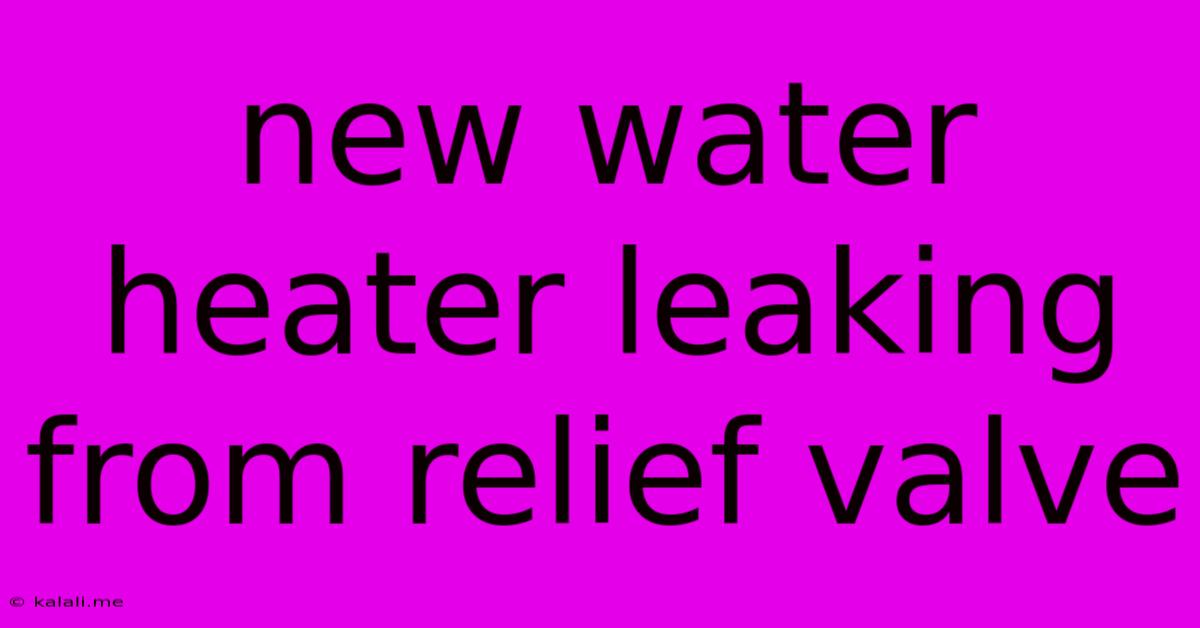New Water Heater Leaking From Relief Valve
Kalali
May 29, 2025 · 4 min read

Table of Contents
New Water Heater Leaking From Relief Valve: Troubleshooting and Solutions
A brand new water heater leaking from the temperature and pressure (T&P) relief valve is a frustrating problem. This seemingly simple appliance malfunction can quickly escalate into a costly repair or even water damage if not addressed promptly. This article will guide you through the common causes of this issue and provide practical troubleshooting steps and solutions. Understanding why your new water heater is leaking is crucial for preventing future issues and ensuring the safety of your home.
Understanding the Temperature and Pressure Relief Valve
Before diving into troubleshooting, let's briefly understand the T&P valve's function. This vital safety device prevents dangerous pressure buildup inside the water heater tank. If the water temperature gets too high or pressure exceeds a certain limit (typically around 150 PSI), the valve automatically opens, releasing hot water to prevent tank rupture. A leak from this valve indicates that the pressure relief mechanism is actively working, but the underlying cause needs attention.
Common Causes of a Leaking T&P Valve on a New Water Heater
Several factors can trigger a leak from your new water heater's T&P valve. Let's explore the most frequent culprits:
- Excessive Water Pressure: This is often the primary reason for a leaking T&P valve. High water pressure in your home's plumbing system forces the valve to open. Check your home's water pressure using a pressure gauge; ideal pressure is typically between 40 and 60 PSI.
- Faulty T&P Valve: While rare in a brand new water heater, a defective valve can malfunction and leak even at normal pressure. Manufacturing defects can cause internal components to fail.
- Sediment Buildup (Less Likely in a New Heater): Although unlikely in a new water heater, mineral deposits and sediment can obstruct the valve's internal workings, hindering proper operation and potentially causing a leak.
- Thermal Expansion: As water heats up, it expands. This expansion increases pressure within the tank. If the expansion is excessive, it can trigger the T&P valve. This can be exacerbated by a faulty thermostat or a malfunctioning heating element.
- Incorrect Installation: Incorrect installation of the water heater can lead to increased pressure and subsequently cause the T&P valve to leak. A poorly installed unit might lack proper venting or have faulty connections.
Troubleshooting Steps
Here's a step-by-step guide to help you identify the cause of the leak:
- Check Your Home's Water Pressure: Use a pressure gauge to measure the water pressure at a faucet. If the pressure is above 60 PSI, you'll need a pressure regulator installed on your main water line to reduce the pressure.
- Inspect the T&P Valve: Carefully examine the valve for any visible damage, cracks, or corrosion. A faulty valve will require replacement.
- Check for Sediment Buildup (Less Likely): Although unlikely in a new system, if you suspect sediment, carefully inspect the valve for any visible buildup. If found, you might need to consult a plumber.
- Examine the Water Heater's Installation: Verify the water heater's proper installation. Check for any loose connections, kinks in the pipes, or air pockets in the system. Consult a professional for any concerns about the installation.
- Test the Thermostat and Heating Element (Advanced): If you suspect problems with temperature control, turning off the water heater for a while might help to observe changes in leak behavior. However, this usually is not the first troubleshooting step.
Solutions
Based on the identified cause, the solutions will vary:
- High Water Pressure: Install a pressure regulator to lower the water pressure to the ideal range.
- Faulty T&P Valve: Replace the T&P valve with a new one. This is a relatively simple DIY task for those comfortable with plumbing, but professional help is always an option.
- Sediment Buildup: Consult a plumber for professional cleaning or flushing of the water heater.
- Incorrect Installation: Correct the installation issues with professional help as needed.
When to Call a Plumber
If you're uncomfortable performing any of the troubleshooting steps or if the leak persists after trying the solutions, contact a qualified plumber. They can accurately diagnose the problem and perform the necessary repairs. A leaking T&P valve is a serious issue that needs immediate attention.
Remember, safety should always be your priority. Dealing with hot water and high pressure requires caution. If unsure about any of these steps, seek professional help. This proactive approach can save you from potential damage and ensure the longevity of your new water heater.
Latest Posts
Latest Posts
-
How To Add Oil To Ac Compressor
May 30, 2025
-
Bare Wood Has Blotchy Stains On It
May 30, 2025
-
How Long Does It Take Glue To Dry
May 30, 2025
-
How To Make Bees Go Away
May 30, 2025
-
Was Jesus Born In A Cave
May 30, 2025
Related Post
Thank you for visiting our website which covers about New Water Heater Leaking From Relief Valve . We hope the information provided has been useful to you. Feel free to contact us if you have any questions or need further assistance. See you next time and don't miss to bookmark.